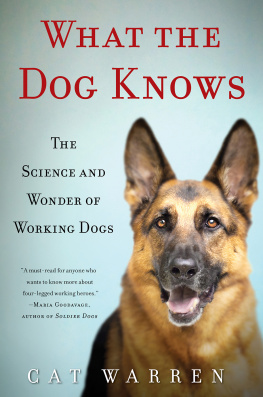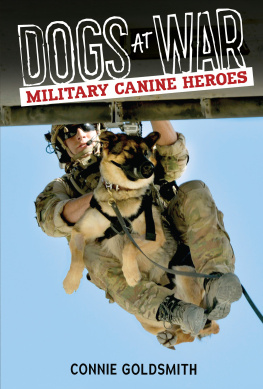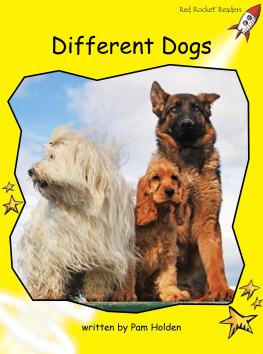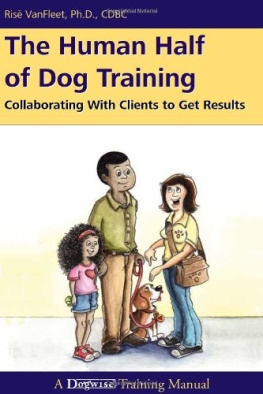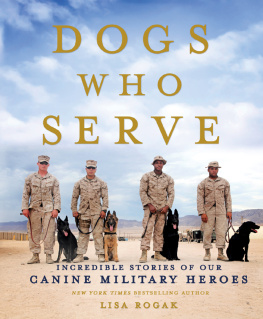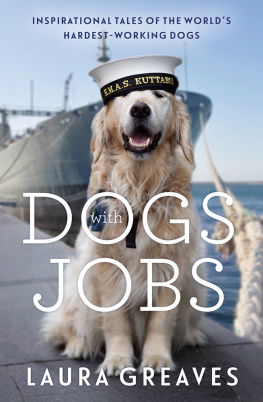More advance praise for What the Dog Knows
[Warrens] painstaking research on the history and science of working dogs debunks myths and explains what is knownand how much remains unknownabout canine abilities and behavior. By combining this hard information with anecdotes about training Solo, accounts of searching the North Carolina woods for dead bodies, and stories of other trainers and their dogs, she has produced a book that is both informative and entertaining. Although her love for Solo is palpable, she remains analytical and clear-headed, never romanticizing what he or other working dogs do.
Bruce DeSilva, Edgar Awardwinning author of the Mulligan crime novels
In a series of accounts that sometimes read like detective stories, Cat Warren... takes us through the steps needed to create dogs that search for peopleboth living and deadwhile describing her life and her special bond with a German shepherd named Solo.
Stanley Coren, author of Born to Bark and Do Dogs Dream?
What the Dog Knows is first the story of the relationship between a hard-working cadaver dog and his human companion. But that deeply felt relationship opens the way to an exploration of the working-dog world and, in doing so, becomes something morea realization of the intelligence, determination, and decency of these animals, a story both wonderful and wise.
Deborah Blum, author of Love at Goon Park: Harry Harlow and the Science of Affection
The capabilities of these specially trained working dogs are remarkable. The author provides fascinating insider information about a meaningful partnership that has important legal and personal consequences.
Amy Hempel
Cat Warren has captured both the magic and the best science behind the success of the modern working dog. This book masterfully shows how even the best technology cannot compete with our best friends. If you have ever wondered what dogs are truly capable of, this is the book for you.
Brian Hare, evolutionary anthropologist, director of Duke Universitys Canine Cognition Center, and co-author of The Genius of Dogs
It doesnt take a dog lover (such as myself) to appreciate Cat Warrens remarkable What the Dog Knows. Prepare to be enthralled and enlightened by this story of Solo and his mistress, whose clear, lively, personal, and intelligent writing will nail you from page one. Its a toss-up as to who is more fascinatingthe dog people or the dogs themselvesin this wonderful and altogether unique book.
Lee Smith, author of The Last Girls
Working dogs, be they search-and-rescue, cadaver, or explosive detection specialists, arelike their human partnersa breed apart. They inhabit a world of complete commitment, utter dedication, and extraordinarily rigorous training. What the Dog Knows is greatly enriched by author Cat Warrens own love of digging. She and Solo take us on some fascinating detours through history and phony-baloney claims en route to the science, wonder, and awe that all rightly surround dogs noses.
Sue Russell, author of Lethal Intent and The Illustrated Courtroom
Thank you for downloading this Touchstone eBook.
Join our mailing list and get updates on new releases, deals, bonus content and other great books from Touchstone and Simon & Schuster.
C LICK H ERE T O S IGN U P
or visit us online to sign up at
eBookNews.SimonandSchuster.com
Contents
To David, my one and only
I crossed a moor, with a name of its own
And a certain use in the world no doubt ,
Yet a hands-breadth of it shines alone
Mid the blank miles round about:
For there I picked up on the heather
And there I put inside my breast
A moulted feather, an eagle-feather
Well, I forget the rest.
Robert Browning, Memorabilia, 1855
Introduction
Ive grown more comfortable working with the dead. With parts of them, really. A few teeth, a vertebra, a piece of carpet that lay underneath a body. One of my German shepherds standard training materials is dirt harvested from sites where decomposing bodies rested. Crack open a Mason jar filled with that dirt, and all I smell is North Carolina woodsmusky darkness with a hint of mildewed alder leaves. Solo smells the departed.
Solo is a cadaver dog. I occasionally get a call asking for our services when someone is missing and most likely dead. People have asked me if Solo gets depressed when he finds someone dead. No. Solos workand his funbegins with someones ending. Nothing makes him happier than a romp in a swamp looking for someone who has been missing for a while. For him, human death is a big game. To win, all he has to do is smell it, get as close as he can to it, tell me about it, and then get his reward: playing tug-of-war with a rope toy.
I never thought death could have an upside. I certainly never expected a dog to point that out to me. Since I started training and working with Solo eight years ago, hes opened a new world to me. Sure, some of it is dark, but gradations of light filter through so much of it that I find it illuminates other spaces in my life.
Solo and I have different reasons for doing this work. What appears to motivate him is not just the tug-toy reward at the end (although that pleases him greatly) but also the work itself, as he sweeps a field like a hyperactive Zamboni on ice, tracking will o the wisps of scent down to their source. What motivates me is watching Solo, a black-and-red shepherd with a big grin and a huge rudder of a tail. He captures the hidden world his nose knows and translates that arcane knowledge for us humans. As one of the K9 unit sergeants said, admiring Solos clear body language, You can read that dog like a book. An easy book, happily, for a working-dog beginner like me. More Dr. Seusss One Fish Two Fish than James Joyces Finnegans Wake. Its a good thing that Solos approach is Seuss-like, because the larger landscape of the missing and dead sometimes keeps me up at night pondering, poking at small details, trying to understand an unknowable plot. As one famous cadaver-dog trainer said, Search is the classic mystery.
My hobby can raise eyebrows. While close friends and a few of my university colleagues embraced the idea with delight, others cringed. With some colleagues, I knew better than to mention it. Mostly, they dont know, as theres no reason to. One administrator, surprised when I told him I had to miss an upcoming faculty meeting to take Solo on a last-minute homicide search, came back to me the next day. Perhaps, he suggested with laudable optimism, I could put cadaver-dog work on my curriculum vitae as extension and outreach? I am not sure this peculiar avocation burnishes my academic credentials. I appreciated his willingness to consider it, though. I know cadaver dogs are an esoteric branch off the working-dog tree, as well as an acquired taste. If someone turns up her nose, I change the subject to politics.
Academics, of course, dont have a monopoly on passing judgment. During a moment of calm at searches, sometimes a sheriff deputy or police officer will ask about what I do for a living. When I tell them I teach at a university, some wince as well, eyeing me for signs of effetenessand weakness. Then, temporarily at least, we forget about our differences and continue the search, where we are on common ground.
Solo has no idea that I have a split life, or that hes partly the cause of it. Why should he? Hes a dog. Hes unaware that human death and decay cause disgust or ambivalence. For him, death is a tug toy. For me, Solo is the ideal intermediary between me and death. When we searchbut even when we trainhe becomes the center of my universe, narrowing my scope to the area were searching. My job is to guide him when needed but let him do his job independent of me, to make sure he has plenty of water and isnt too close to traffic or a backyard Rottweiler, and to watch him closely the entire time, as he tests the air currents and reacts to them.
Next page
